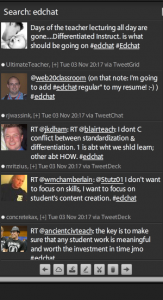Tonight I participated in a global discussion with #edchat about Differentiated Instruction in the classroom.
This has been an area of passion for me since I’ve started teaching, 9 years ago. I have always thought that D.I was simply good teaching – providing choice based on the learners need, interest and profile. Individualize the program, provide regular feedback and facilitate a student centered program. Accommodate. Modify. Listen. Understand. TEACH. I have come to realize that all of my students are on a modified program. The classroom is Universally Designed – first, through the infrastructure and second, through the program. Access to computers, interactive whiteboards, document cameras, speaker system, soundfields, ipods, and individualized lessons through a course management system. The result – student engagement. The result of student engagement is student learning.
Today more than ever we, as educators need to learn to take risks and move away from our own comfort area because true differentiation means that we are delivering content that is current and relevant to our students. Unfortunately, many of our schools and districts are still not providing the infrastructure for teachers to implement a truly relevant and current program- one that students want. One with tools that they know. One that allows access to multi-languages, text to speech software, graphic designing, voice threads, blogging and collaboration.
The discussion prompted me to give an example of how I am going to differentiate a Science Test based on our Biodiversity Unit (Ontario Curriculum). Students will use Google Forms (embedded into Learning.com) to answer a variety of questions that have been discussed. I am not looking for their ability to regurgitate information. I am looking for their ability to connect to what we have discussed. I am looking for their ability to use the resources in front of them to help the devise a good response and to use each other as collaborators. They are encouraged to talk throughout the assessment, to assist each other and to read and analyze information on the that we have read on the internet.
Example of the Google Form: here
Example of Voice Thread – for students who prefer to answer orally.



It sounds fantastic. I like the challenge of integrating technology, especially to address differentiation. On the other hand, I was at work for nearly 12 hours yesterday just correcting and figuring out who was missing what after all the absents. Love the idea of having kids answer orally – hear the question aloud. However, after the 2 months that it took just to get the Photo Story project done – with all the noise in the background (and they really tried to be quiet) I have doubts about how that would function in my classroom. Keep being inspirational.
Wow! What an incredible test, Zoe! You have shown what differentiation in the classroom can really look like. I love how you included VoiceThread as a way for students to respond to.
Your students are so lucky to have such a caring and innovative teacher. Thank you for continuing to be such an inspiration to me too!
Pingback: Tweets that mention A Test with a Twist | PIPEDREAMS -- Topsy.com
Pingback: My Weekly Diigo Bookmarks (weekly) | My Squirrelly View of Education